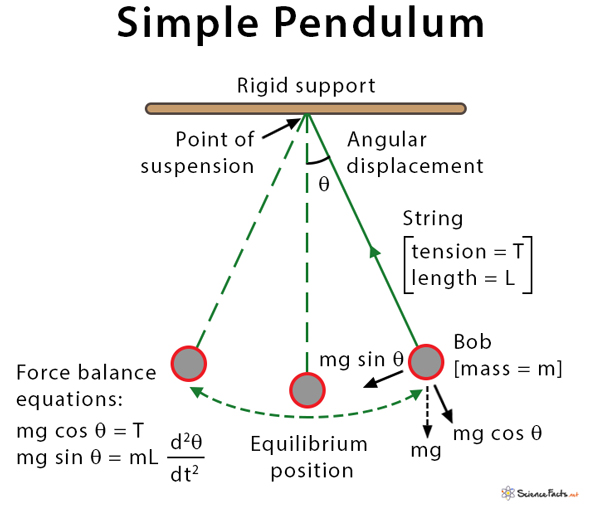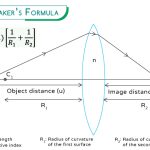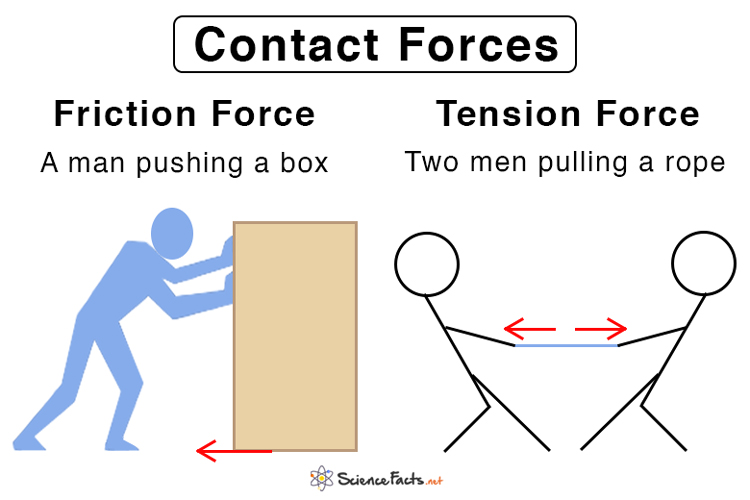
- Why Does Water Expand When It Freezes
- Gold Foil Experiment
- Faraday Cage
- Oil Drop Experiment
- Magnetic Monopole
- Why Do Fireflies Light Up
- Types of Blood Cells With Their Structure, and Functions
- The Main Parts of a Plant With Their Functions
- Parts of a Flower With Their Structure and Functions
- Parts of a Leaf With Their Structure and Functions
- Why Does Ice Float on Water
- Why Does Oil Float on Water
- How Do Clouds Form
- What Causes Lightning
- How are Diamonds Made
- Types of Meteorites
- Types of Volcanoes
- Types of Rocks

Simple Pendulum
Definition: what is a simple pendulum.
A pendulum is a device that is found in wall clocks. It consists of a weight (bob) suspended from a pivot by a string or a very light rod so that it can swing freely. When displaced to an initial angle and released, the pendulum will swing back and forth with a periodic motion. By applying Newton’s second law of motion for rotational systems, the equation of motion for the pendulum may be obtained.

Although the pendulum has a long history, Italian scientist Galileo Galilei was the first to study the properties of pendulums, beginning around 1602.
Terms Associated with Simple Pendulum
Length (L): Distance between the point of suspension to the center of the bob
Time Period (T): Time taken by the pendulum to finish one full oscillation
Linear Displacement (x): Distance traveled by the pendulum bob from the equilibrium position to one side.
Angular Displacement (θ) : The angle described by the pendulum with an imaginary axis at the equilibrium position is called the angular displacement.
Amplitude (x max ): Maximum distance traveled by the pendulum from the equilibrium position to one side before changing its direction. For angle, it is denoted by θ max .
Equation of Simple Pendulum
How to derive the formula for time period.
According to Newton’s second law,
The equation can be written in differential form as
If the amplitude of displacement is small, then the small-angle approximation holds, i.e., sin θ ~ θ.
This equation represents a simple harmonic motion. Thus, the motion of a simple pendulum is a simple harmonic motion with an angular frequency, \( \omega = \sqrt{\frac{g}{L}} \) , and linear frequency, \( f = \frac{1}{2\pi}\sqrt{\frac{g}{L}} \) . The time period is given by,
Performing dimension analysis on the right side of the above equation gives the unit of time.
[L/LT -2 ] 1/2 = [T]
The principle of a simple pendulum can be understood as follows. The restoring force of the pendulum from the above is, F = -mgL θ. This force is responsible for restoring the pendulum to its equilibrium position. However, due to the inertia of motion, the pendulum passes the equilibrium position and swings to the other side. This motion is periodic and can be solved using differential equation analysis.
After solving the differential equation, the angular displacement is given by
θ = θ max sin (ωt)
Sometimes, a phase φ is added to the above equation depending upon the initial conditions of the pendulum. Then, the equation can be written as
θ = θ max sin (ωt + φ)
A simple pendulum is a typical laboratory experiment in many academic curricula. Students are often asked to evaluate the value of the acceleration due to gravity, g, using the equation for the time period of a pendulum. Rearranging the time period equation,
Note that the component mg cos θ is balanced by the tension T of the string, i.e., T = mg cos θ.
Laws of Simple Pendulum
- Law of mass: The time period is independent of the mass of the bob.
- Law of length: The time period is directly proportional to the square root of the length.
- Law of Iscochronism: The time period is independent of the amplitude as long as the amplitude is small.
- Law of gravity: The time period is inversely proportional to the square root of the acceleration due to gravity at that place.
Uses and Applications of the Simple Pendulum
- Pendulum clock – A common household item. Every time the pendulum swings, the clock’s hand advances at a fixed rate, thus giving the time.
- Old seismometers – A pendulum with a stylus at its bottom was connected to a frame. During an earthquake, the frame moves and causes the stylus to form a pattern on paper.
- Pendulum gravimeter – A pendulum is used to measure the local gravity.
- Foucault’s pendulum – A device to measure the rotation of the earth.
- Metronome – A device used by musicians. It emits a click or a light for each beat of a predetermined interval.
- The Simple Pendulum – Acs.psu.edu
- Simple Pendulum – Hyperphysics.phy-astr.gsu.edu
- The Simple Pendulum (Simple Harmonic Motion) – Deanza.edu
- The Simple Pendulum – Iu.pressbooks.pub
- Applications of Differential Equations – Calculuslab.deltacollege.edu
- Real-world applications of Pendulums – Sites.google.com
- The Use of Pendulums in the Real World – Sciencing.com
- Oscillation of a Simple Pendulum – Acs.psu.edu
- Simple pendulum – Amrita.olabs.edu.in
Article was last reviewed on Saturday, September 30, 2023
Related articles

Leave a Reply Cancel reply
Your email address will not be published. Required fields are marked *
Save my name, email, and website in this browser for the next time I comment.
Popular Articles

Join our Newsletter
Fill your E-mail Address

Related Worksheets
- Privacy Policy
© 2024 ( Science Facts ). All rights reserved. Reproduction in whole or in part without permission is prohibited.
Want to create or adapt books like this? Learn more about how Pressbooks supports open publishing practices.
16 Oscillatory Motion and Waves
119 16.4 The Simple Pendulum
- Measure acceleration due to gravity.

Pendulums are in common usage. Some have crucial uses, such as in clocks; some are for fun, such as a child’s swing; and some are just there, such as the sinker on a fishing line. For small displacements, a pendulum is a simple harmonic oscillator. A simple pendulum is defined to have an object that has a small mass, also known as the pendulum bob, which is suspended from a light wire or string, such as shown in Figure 1 . Exploring the simple pendulum a bit further, we can discover the conditions under which it performs simple harmonic motion, and we can derive an interesting expression for its period.
We begin by defining the displacement to be the arc length[latex]\boldsymbol{s}.[/latex]We see from Figure 1 that the net force on the bob is tangent to the arc and equals[latex]\boldsymbol{-mg\sin\theta}.[/latex](The weight[latex]\boldsymbol{mg}[/latex]has components[latex]\boldsymbol{mg\cos\theta}[/latex]along the string and[latex]\boldsymbol{mg\sin\theta}[/latex]tangent to the arc.) Tension in the string exactly cancels the component[latex]\boldsymbol{mg\cos\theta}[/latex]parallel to the string. This leaves a net restoring force back toward the equilibrium position at[latex]\boldsymbol{\theta=0}.[/latex]
Now, if we can show that the restoring force is directly proportional to the displacement, then we have a simple harmonic oscillator. In trying to determine if we have a simple harmonic oscillator, we should note that for small angles (less than about[latex]\boldsymbol{15^0}[/latex]),[latex]\boldsymbol{\sin\theta\approx\theta}[/latex]([latex]\boldsymbol{\sin\theta}[/latex]and[latex]\boldsymbol{\theta}[/latex]differ by about 1% or less at smaller angles). Thus, for angles less than about[latex]\boldsymbol{15^0},[/latex]the restoring force[latex]\boldsymbol{F}[/latex]is
The displacement[latex]\boldsymbol{s}[/latex]is directly proportional to[latex]\boldsymbol{\theta}.[/latex]When[latex]\boldsymbol{\theta}[/latex]is expressed in radians, the arc length in a circle is related to its radius ([latex]\boldsymbol{L}[/latex]in this instance) by:
For small angles, then, the expression for the restoring force is:
This expression is of the form:
where the force constant is given by[latex]\boldsymbol{k=mg/L}[/latex]and the displacement is given by[latex]\boldsymbol{x=s}.[/latex]For angles less than about[latex]\boldsymbol{15^0},[/latex]the restoring force is directly proportional to the displacement, and the simple pendulum is a simple harmonic oscillator.
Using this equation, we can find the period of a pendulum for amplitudes less than about[latex]\boldsymbol{15^0}.[/latex]For the simple pendulum:
for the period of a simple pendulum. This result is interesting because of its simplicity. The only things that affect the period of a simple pendulum are its length and the acceleration due to gravity. The period is completely independent of other factors, such as mass. As with simple harmonic oscillators, the period[latex]\boldsymbol{T}[/latex]for a pendulum is nearly independent of amplitude, especially if[latex]\boldsymbol{\theta}[/latex]is less than about[latex]\boldsymbol{15^0}.[/latex]Even simple pendulum clocks can be finely adjusted and accurate.
Note the dependence of[latex]\boldsymbol{T}[/latex]on[latex]\boldsymbol{g}.[/latex]If the length of a pendulum is precisely known, it can actually be used to measure the acceleration due to gravity. Consider the following example.
Example 1: Measuring Acceleration due to Gravity: The Period of a Pendulum
What is the acceleration due to gravity in a region where a simple pendulum having a length 75.000 cm has a period of 1.7357 s?
We are asked to find[latex]\boldsymbol{g}[/latex]given the period[latex]\boldsymbol{T}[/latex]and the length[latex]\boldsymbol{L}[/latex]of a pendulum. We can solve[latex]\boldsymbol{T=2\pi\sqrt{\frac{L}{g}}}[/latex]for[latex]\boldsymbol{g},[/latex]assuming only that the angle of deflection is less than[latex]\boldsymbol{15^0}.[/latex]
Square[latex]\boldsymbol{T=2\pi\sqrt{\frac{L}{g}}}[/latex]and solve for[latex]\boldsymbol{g}:[/latex]
[latex]\boldsymbol{g=4\pi^2}[/latex][latex]\boldsymbol{\frac{L}{T^2}}.[/latex]
Substitute known values into the new equation:
[latex]\boldsymbol{g=4\pi^2}[/latex][latex]\boldsymbol{\frac{0.75000\textbf{ m}}{(1.7357\textbf{ s})^2}}.[/latex]
Calculate to find[latex]\boldsymbol{g}:[/latex]
This method for determining[latex]\boldsymbol{g}[/latex]can be very accurate. This is why length and period are given to five digits in this example. For the precision of the approximation[latex]\boldsymbol{\sin\theta\approx\theta}[/latex]to be better than the precision of the pendulum length and period, the maximum displacement angle should be kept below about[latex]\boldsymbol{0.5^{/circ}}.[/latex]
MAKING CAREER CONNECTIONS
Knowing[latex]\boldsymbol{g}[/latex]can be important in geological exploration; for example, a map of[latex]\boldsymbol{g}[/latex]over large geographical regions aids the study of plate tectonics and helps in the search for oil fields and large mineral deposits.
TAKE-HOME EXPERIMENT: DETERMINING g
Use a simple pendulum to determine the acceleration due to gravity[latex]\boldsymbol{g}[/latex]in your own locale. Cut a piece of a string or dental floss so that it is about 1 m long. Attach a small object of high density to the end of the string (for example, a metal nut or a car key). Starting at an angle of less than[latex]\boldsymbol{10^0},[/latex]allow the pendulum to swing and measure the pendulum’s period for 10 oscillations using a stopwatch. Calculate[latex]\boldsymbol{g}.[/latex]How accurate is this measurement? How might it be improved?
Check Your Understanding
An engineer builds two simple pendula. Both are suspended from small wires secured to the ceiling of a room. Each pendulum hovers 2 cm above the floor. Pendulum 1 has a bob with a mass of[latex]\boldsymbol{10\textbf{ kg}}.[/latex]Pendulum 2 has a bob with a mass of[latex]\boldsymbol{100\textbf{ kg}}.[/latex]Describe how the motion of the pendula will differ if the bobs are both displaced by[latex]\boldsymbol{12^0}.[/latex]
PHET EXPLORATIONS: PENDULUM LAB
Play with one or two pendulums and discover how the period of a simple pendulum depends on the length of the string, the mass of the pendulum bob, and the amplitude of the swing. It’s easy to measure the period using the photogate timer. You can vary friction and the strength of gravity. Use the pendulum to find the value of[latex]\boldsymbol{g}[/latex]on planet X. Notice the anharmonic behavior at large amplitude.
Section Summary
The period of a simple pendulum is
where[latex]\boldsymbol{L}[/latex]is the length of the string and[latex]\boldsymbol{g}[/latex]is the acceleration due to gravity.
Conceptual Questions
1: Pendulum clocks are made to run at the correct rate by adjusting the pendulum’s length. Suppose you move from one city to another where the acceleration due to gravity is slightly greater, taking your pendulum clock with you, will you have to lengthen or shorten the pendulum to keep the correct time, other factors remaining constant? Explain your answer.
Problems & Exercises
As usual, the acceleration due to gravity in these problems is taken to be [latex]\boldsymbol{g=9.80\textbf{ m/s}^2},[/latex] unless otherwise specified.
1: What is the length of a pendulum that has a period of 0.500 s?
2: Some people think a pendulum with a period of 1.00 s can be driven with “mental energy” or psycho kinetically, because its period is the same as an average heartbeat. True or not, what is the length of such a pendulum?
3: What is the period of a 1.00-m-long pendulum?
4: How long does it take a child on a swing to complete one swing if her center of gravity is 4.00 m below the pivot?
5: The pendulum on a cuckoo clock is 5.00 cm long. What is its frequency?
6: Two parakeets sit on a swing with their combined center of mass 10.0 cm below the pivot. At what frequency do they swing?
7: (a) A pendulum that has a period of 3.00000 s and that is located where the acceleration due to gravity is[latex]\boldsymbol{9.79\textbf{ m/s}^2}[/latex]is moved to a location where it the acceleration due to gravity is[latex]\boldsymbol{9.82\textbf{ m/s}^2}.[/latex]What is its new period? (b) Explain why so many digits are needed in the value for the period, based on the relation between the period and the acceleration due to gravity.
8: A pendulum with a period of 2.00000 s in one location[latex]\boldsymbol{(g=9.80\textbf{ m/s}^2)}[/latex]is moved to a new location where the period is now 1.99796 s. What is the acceleration due to gravity at its new location?
9: (a) What is the effect on the period of a pendulum if you double its length?
(b) What is the effect on the period of a pendulum if you decrease its length by 5.00%?
10: Find the ratio of the new/old periods of a pendulum if the pendulum were transported from Earth to the Moon, where the acceleration due to gravity is[latex]\boldsymbol{1.63\textbf{ m/s}^2}.[/latex]
11: At what rate will a pendulum clock run on the Moon, where the acceleration due to gravity is[latex]\boldsymbol{1.63\textbf{ m/s}^2},[/latex]if it keeps time accurately on Earth? That is, find the time (in hours) it takes the clock’s hour hand to make one revolution on the Moon.
12: Suppose the length of a clock’s pendulum is changed by 1.000%, exactly at noon one day. What time will it read 24.00 hours later, assuming it the pendulum has kept perfect time before the change? Note that there are two answers, and perform the calculation to four-digit precision.
13: If a pendulum-driven clock gains 5.00 s/day, what fractional change in pendulum length must be made for it to keep perfect time?
1: The movement of the pendula will not differ at all because the mass of the bob has no effect on the motion of a simple pendulum. The pendula are only affected by the period (which is related to the pendulum’s length) and by the acceleration due to gravity.
(a) 2.99541 s
(b) Since the period is related to the square root of the acceleration of gravity, when the acceleration changes by 1% the period changes by[latex]\boldsymbol{(0.01)^2=0.01\%}[/latex]so it is necessary to have at least 4 digits after the decimal to see the changes.
(a) Period increases by a factor of 1.41 ([latex]\boldsymbol{\sqrt{2}}[/latex])
(b) Period decreases to 97.5% of old period
Slow by a factor of 2.45
length must increase by 0.0116%.
College Physics chapters 1-17 Copyright © August 22, 2016 by OpenStax is licensed under a Creative Commons Attribution 4.0 International License , except where otherwise noted.
Share This Book

IMAGES
VIDEO